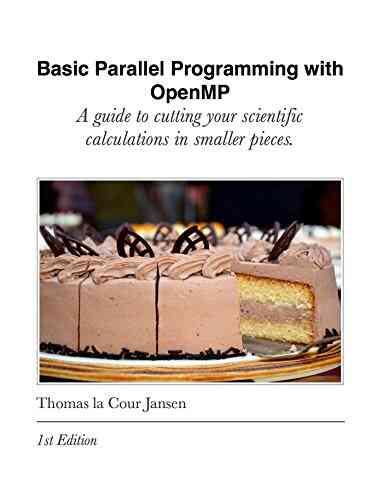A Comprehensive Guide To Cutting Your Scientific Calculations In Smaller Pieces

Are you tired of tackling complex scientific calculations that seem overwhelming? Do you struggle to break down lengthy equations and formulas? If so, you've come to the right place! In this comprehensive guide, we will explore effective strategies to help you cut your scientific calculations into smaller, more manageable pieces, ensuring a smoother problem-solving process.
Understanding the Importance of Breaking Down Calculations
Scientific calculations often involve complex equations and lengthy formulas. Attempting to solve them as a whole can be overwhelming and counterproductive. Breaking down these calculations into smaller pieces allows us to focus on specific components, making the problem-solving process more efficient and less prone to errors.
Step 1: Analyzing the Problem
The first step in cutting your scientific calculations into smaller pieces is to carefully analyze the problem. Identify the key variables, constants, and relationships involved. By gaining a clear understanding of the problem at hand, you can determine the most effective approach to solving it.
4 out of 5
| Language | : | English |
| File size | : | 1113 KB |
| Text-to-Speech | : | Enabled |
| Screen Reader | : | Supported |
| Enhanced typesetting | : | Enabled |
| Print length | : | 15 pages |
| Lending | : | Enabled |
Step 2: Simplify Complex Equations
Long, complex equations can be intimidating, but by simplifying them, you can make them more manageable. Identify any sub-equations or components within the main equation and solve them separately. This way, you can break down the problem into smaller, more solvable parts, simplifying the overall calculation process.
Step 3: Utilize Computer Programs and Tools
In today's digital age, we are fortunate to have access to advanced computer programs and tools specifically designed to simplify scientific calculations. Take advantage of these resources to break down your calculations into more manageable chunks. These tools can help you solve complex equations, visualize data, and automate repetitive tasks, saving you valuable time and effort.
Step 4: Divide and Conquer
Another effective strategy is to divide your calculations into smaller, more manageable tasks. By breaking down the problem into bite-sized pieces, you can focus on solving each task individually. Once you have solved all the smaller tasks, you can combine the results to obtain the final solution. This approach not only makes the problem more approachable but also allows for easier error detection and troubleshooting.
Step 5: Seek Collaboration and Feedback
Scientific calculations can be complex, and seeking collaboration or feedback from peers or experts in the field can be invaluable. By sharing your calculations with others, you can gain fresh perspectives and identify potential areas for improvement. Collaborative problem-solving can help you identify new approaches or methods that you may have overlooked, further simplifying the calculation process.
Step 6: Practice and Patience
Like any skill, cutting scientific calculations into smaller pieces requires practice and patience. Do not get discouraged if you encounter difficulties along the way. With time and perseverance, you will develop the ability to identify patterns, break down complex calculations, and solve them more efficiently. Consistent practice will enhance your problem-solving skills, making scientific calculations less daunting in the long run.
, cutting your scientific calculations into smaller pieces is a beneficial technique that enhances problem-solving efficiency and reduces errors. By following the steps outlined in this guide, you can simplify complex equations, utilize helpful tools, seek collaboration, and improve your problem-solving skills. Remember, practice and patience are key to mastering this approach. So, embrace the strategy, break down those calculations, and conquer the scientific complexities with confidence!
4 out of 5
| Language | : | English |
| File size | : | 1113 KB |
| Text-to-Speech | : | Enabled |
| Screen Reader | : | Supported |
| Enhanced typesetting | : | Enabled |
| Print length | : | 15 pages |
| Lending | : | Enabled |
This book provides the basic description of writing parallel programs using the OpenMP language. Simple examples related to common problems faced in scientific applications are given. The reader is assumed to know either C or FORTRAN. The book was written for a two-hour crash course on OpenMP programming for master and PhD students in Chemistry and Physics.
Do you want to contribute by writing guest posts on this blog?
Please contact us and send us a resume of previous articles that you have written.




















Light bulbAdvertise smarter! Our strategic ad space ensures maximum exposure. Reserve your spot today!

 Ismael HayesThe Epic Tales of Nathaniel Drinkwater: Dive into the Captivating World of...
Ismael HayesThe Epic Tales of Nathaniel Drinkwater: Dive into the Captivating World of...
 Luke BlairThe Painful Nature Of Nothing In Hemingway's "Clean Well Lighted Place" Short...
Luke BlairThe Painful Nature Of Nothing In Hemingway's "Clean Well Lighted Place" Short... Aubrey BlairFollow ·7.2k
Aubrey BlairFollow ·7.2k Felix HayesFollow ·2.6k
Felix HayesFollow ·2.6k Gene SimmonsFollow ·3.8k
Gene SimmonsFollow ·3.8k Diego BlairFollow ·19.3k
Diego BlairFollow ·19.3k Amir SimmonsFollow ·15.7k
Amir SimmonsFollow ·15.7k Harrison BlairFollow ·19.1k
Harrison BlairFollow ·19.1k Tennessee WilliamsFollow ·9.6k
Tennessee WilliamsFollow ·9.6k Phil FosterFollow ·13.9k
Phil FosterFollow ·13.9k

 Dwayne Mitchell
Dwayne MitchellSaving The Maldives: The Floating Island
The Maldives, known for...

 Ethan Mitchell
Ethan MitchellManaging The Production Hour: Mastering Efficiency and...
As businesses strive to meet growing demands...

 Virginia Woolf
Virginia WoolfThe Food Lab: Better Home Cooking Through Science
Have you ever wondered why some...

 Jeff Foster
Jeff FosterThe Darling Songbirds: The Songbirds of Darling Bay
When it comes to enchanting melodies and...

 Eli Blair
Eli BlairDeath And New Life In Pandemic
The COVID-19 pandemic has brought about...

 Dave Simmons
Dave SimmonsThe Unstoppable Nathan Run: A Thrilling Journey Into John...
When it comes to gripping thriller novels,...

 Amir Simmons
Amir SimmonsDistant Horizon Backyard Starship: Exploring the Cosmos...
The mysteries of the universe...

 Simon Mitchell
Simon MitchellUnveiling the Secrets: The DNA of a Disciple - A...
Do you ever wonder what it takes to become a...

 Samuel Taylor Coleridge
Samuel Taylor ColeridgeThe Epic Tale of Snake River Slaughter: Matt Jensen, The...
The Snake River, winding through the...

 Ray Blair
Ray BlairThe Ultimate Covid Alphabet For Teachers: The Key to a...
With the Covid-19 pandemic still ongoing,...

 Gage Hayes
Gage HayesFor The Sake Of Family: Why Prioritizing Our Loved Ones...
Family is the backbone of...
4 out of 5
| Language | : | English |
| File size | : | 1113 KB |
| Text-to-Speech | : | Enabled |
| Screen Reader | : | Supported |
| Enhanced typesetting | : | Enabled |
| Print length | : | 15 pages |
| Lending | : | Enabled |

















